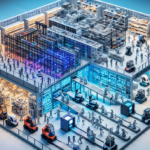Introduction to Automated Warehouse Robotics
Automated warehouse solutions have revolutionized the warehousing industry by significantly enhancing productivity and overall efficiency. Among the leading solutions are Kiva Systems (now known as Amazon Robotics) and Fetch Robotics. This article provides a comprehensive comparison of these two systems, helping businesses determine which is better suited to their operational needs.
Overview of Kiva Systems (Amazon Robotics) and Fetch Robotics
Kiva Systems, rebranded as Amazon Robotics after Amazon's acquisition in 2012, specializes in a fleet of autonomous robots that navigate warehouse floors to perform tasks such as picking, packing, and transporting items. Fetch Robotics, based in San Jose, California, offers automated solutions through mobile robots designed to retrieve items from shelves and transport them to designated locations.
Both systems have transformed warehouse operations by increasing efficiency and reducing reliance on human labor. Utilizing advanced algorithms and sensors, they navigate warehouse environments while avoiding obstacles and communicating seamlessly with each other and human operators to ensure tasks are completed accurately and promptly.
Key Advantages and Features
Advantages of Kiva Systems (Amazon Robotics)
Kiva Systems' primary advantage lies in its extensive use of autonomous mobile robots that efficiently move large quantities of inventory, reducing human intervention and minimizing errors. The system handles a diverse range of products, making it suitable for warehouses managing various types of goods.
Additionally, Amazon Robotics offers real-time inventory tracking and management, allowing warehouse managers to monitor inventory levels and track product movements seamlessly. The system supports easy reorganization of inventory, as robots can swiftly relocate products within the warehouse. This integrated approach enhances operational efficiency and inventory management.
Advantages of Fetch Robotics
Fetch Robotics offers superior flexibility in product handling compared to Kiva Systems. Their mobile robots can retrieve items from shelves and transport them to designated locations while adeptly avoiding obstacles. Implementing Fetch Robotics can lead to reduced labor costs and increased overall operational efficiency.
Fetch Robotics' robots are designed to collaborate with human workers, assisting in tasks such as picking and packing. This collaboration allows human workers to focus on more complex duties, boosting productivity. Equipped with advanced sensors and mapping technology, Fetch Robotics' robots navigate complex warehouse environments with ease, resulting in faster and more accurate order fulfillment.
Cost-effectiveness and Pricing
Cost-effectiveness is a critical consideration when choosing between Kiva Systems and Fetch Robotics. Generally, Fetch Robotics tends to be more cost-effective due to the lower cost of its mobile robots. However, Kiva Systems provide a more comprehensive solution, encompassing not only mobile robots but also inventory management software and hardware, which can be advantageous for larger warehouses requiring an integrated system.
Customization and flexibility also play a role in cost-effectiveness. Kiva Systems are known for their highly customizable solutions tailored to specific warehouse needs, which can lead to higher upfront costs but greater long-term efficiency. In contrast, Fetch Robotics offers more standardized solutions that are easier to implement and maintain, potentially reducing overall costs for businesses with less complex requirements.
Performance Metrics: Speed, Accuracy, and Efficiency
Both Kiva Systems and Fetch Robotics deliver impressive performance metrics. Kiva Systems' robots operate at an average speed of 5 mph with an accuracy rate of 99.99%. In comparison, Fetch Robotics' robots can reach speeds of up to 10 mph with an accuracy rate of 99.999%.
Despite Fetch Robotics' superior speed and accuracy, Kiva Systems excel in efficiency through their cohesive operation, optimizing space utilization and minimizing task completion time. This allows Kiva Systems to handle a higher volume of orders in a shorter timeframe compared to Fetch Robotics.
Furthermore, Kiva Systems' modular design makes scaling more cost-effective, as warehouses can start with a smaller system and expand as needed without replacing the entire setup.
Integration with Warehouse Management Systems (WMS)
Both Kiva Systems and Fetch Robotics integrate seamlessly with existing Warehouse Management Systems (WMS). Kiva Systems integrate particularly well with Amazon's proprietary warehouse management software, enhancing ease of use for Amazon-centric operations. Similarly, Fetch Robotics can integrate with most warehouse systems, providing an accessible solution for various businesses.
However, the level of integration may vary depending on the specific WMS in use. Some systems may require additional customization and configuration to function optimally with either Kiva or Fetch Robotics. It is recommended to consult a professional integrator to ensure a smooth and efficient integration process.
Case Studies and Industry Adoption
Numerous companies have successfully implemented both Kiva Systems and Fetch Robotics in their warehouses. Notable businesses that have adopted Kiva Systems include The Gap, Staples, and Diapers.com. Meanwhile, Fetch Robotics has been deployed by companies such as DHL, Ricoh, and RK Logistics.
These implementations have demonstrated significant improvements in operational efficiency, order fulfillment speed, and inventory accuracy. For instance, DHL reported a 20% increase in order processing speed after deploying Fetch Robotics’ autonomous mobile robots.
Impact of COVID-19 and Future Trends in Warehouse Robotics
The COVID-19 pandemic accelerated the adoption of automated warehouse solutions, as businesses sought to sustain operations amid disruptions. Automated solutions proved invaluable in maintaining social distancing and minimizing human contact, thereby enhancing workplace safety.
Moreover, the pandemic caused significant disruptions in global supply chains, leading to shortages of essential goods and materials. Automated warehouse solutions helped mitigate these disruptions by enhancing inventory management and reducing order processing times. This has spurred interest in automated solutions for both immediate pandemic-related benefits and long-term improvements in supply chain resilience.
Looking ahead, the future of warehouse robotics is promising, with ongoing developments aimed at enhancing the versatility and intelligence of robots. Integration of artificial intelligence (AI) and machine learning will further improve the accuracy and efficiency of warehouse operations, enabling more sophisticated decision-making and adaptability.
Expert Opinions on Kiva Systems vs. Fetch Robotics
Experts in warehouse automation highlight that Kiva Systems' robots are ideal for handling large volumes of inventory, making them suitable for extensive warehouse operations. On the other hand, Fetch Robotics' mobile robots are better suited for small to medium-sized warehouses that require flexibility and agility.
It is also noted that both systems involve significant initial investments and ongoing maintenance costs. However, the choice between the two ultimately depends on the specific needs and scale of the warehouse operations.
Conclusion: Choosing the Right System for Your Business
In conclusion, both Kiva Systems and Fetch Robotics offer distinct strengths and limitations. The optimal choice depends on your business's unique needs and requirements. Businesses prioritizing versatility in product handling and cost-effectiveness may find Fetch Robotics more suitable. Conversely, Kiva Systems may offer a better solution for warehouses needing to manage large volumes of inventory efficiently.
Ultimately, evaluating factors such as warehouse size, product complexity, budget, and integration capabilities will help determine the most appropriate automated warehouse solution for your business.




















